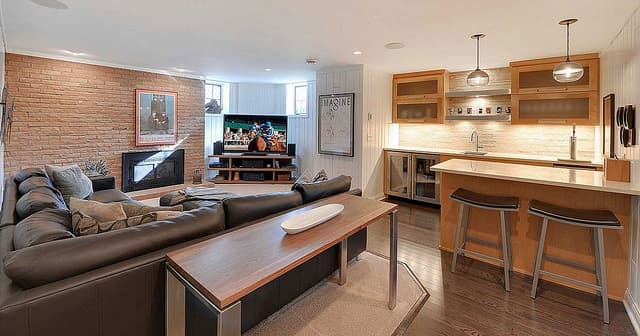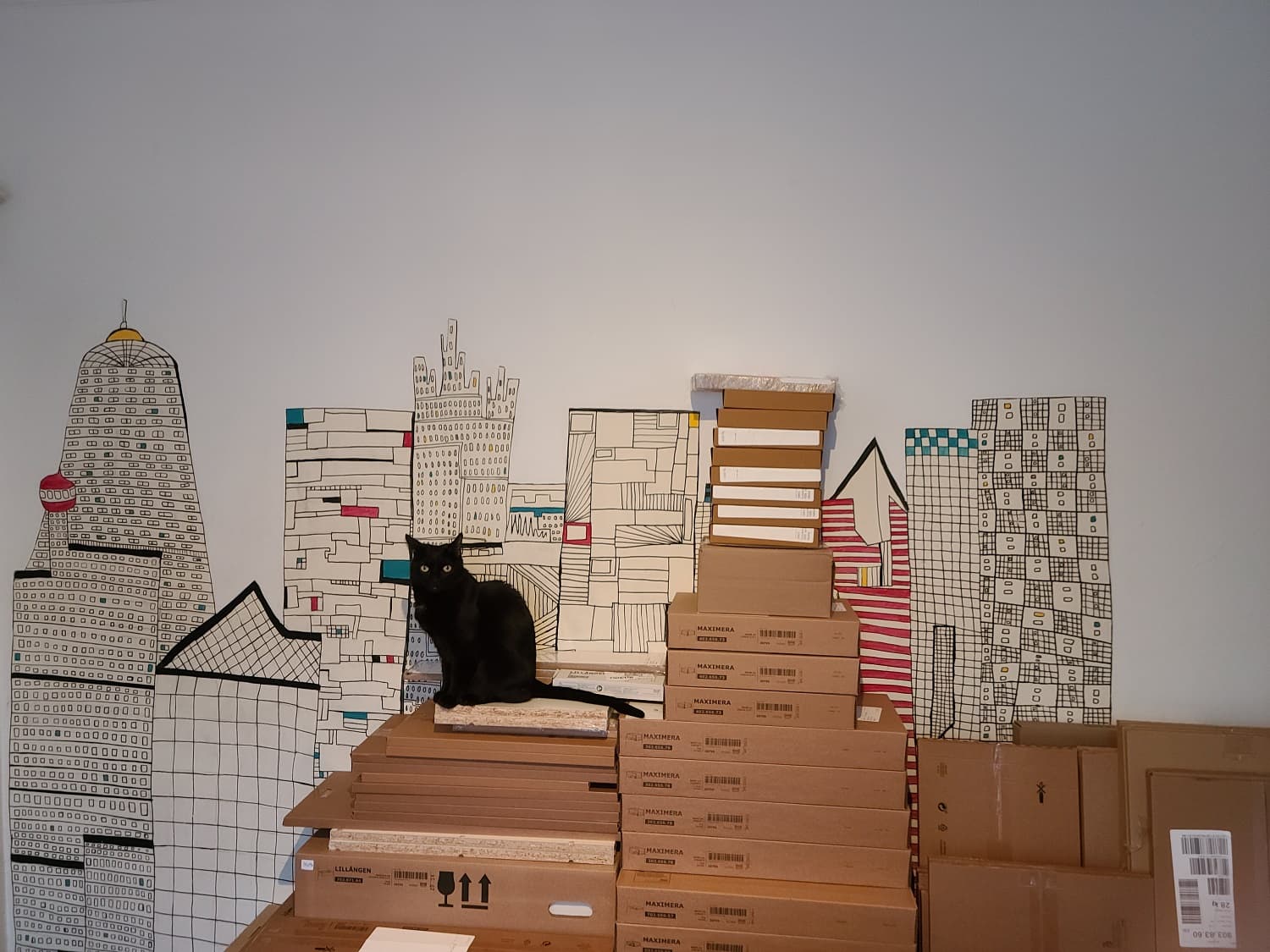
Storage space for some, unfinished room for others, yet thanks to its size the basement is a part of the house brimming with possibilities. Whether you’re ready to invest or get inventive, there is no limit to your comfort. Make your basement transformation a reality without having to quash your creativity.
Are you currently organizing a basement renovation project? We've prepared a highly practical checklist to help you manage the different steps involved in this project.
Click here to check it out and be sure to keep it handy

Cover photo and photo hereabove: Highmark Builders
1) How to brighten up a basement?
The basement is probably the part of the house that receives the least light, so why not illuminate it? Opt for materials that reflect or let light pass through, as well as for organic materials transposing the exterior inside. Think of integrating raw materials with light colours: blond wood, white stone and beige jute carpeting.
A fireplace in the center of the room will provide a natural glow. To warm the basements’ cold floor, seal it with an epoxy for a shiny finish or choose a lightly coloured coating.
Replace a traditional door with transparent glass or plexiglass behind which you can make a wine cellar. For furniture, opt for materials that reflect light: leather, varnish, and glossy finishes. Then combine your fixtures to add light to the entire area, without forgetting about the blinds or white curtains for the windows.
Looking to buy blinds?
We recommend Quebec-based company Hey Blinds Canada: custom-made blinds, sought-after products, but above all else, the best warranties for a stress-free purchase.
2) How to expand the space in a basement?
Now that the basement is receiving more light, wouldn’t you like to maximize the space? If you’re tired of the immaculate white that’s persisted since the construction of your home, repaint the walls and floor with a palette of cooler or pastel shades. This will give the impression that the space is bigger than it is.
To soften the rectilinear space, opt for furniture with round lines and alternate between new and old pieces. To anchor this timeless charm, a textured rug made of natural fibres or very vibrant patterns will help stabilize the furniture and offset their floating. Also, install mirrors in front of windows and place shelves to create order while freeing up space.
Photo: Atomly
3) How to convert a basement affordably?
Your basement already has potential so why not highlight it in all its simplicity? If you have a low-hanging ceiling, it is better to paint the beams and ceiling in white than to install a suspended ceiling which will cause you to lose space. With slippers on your feet, does the cold concrete slab not bother you?
Then paint your floor using stencils. If you have plywood installed, paint it with a checkerboard pattern of your choice. To create divisions, use fabrics, old wooden pallets, or whatever you can get your hands on. Keep the rustic appeal of materials like stairs or rawly exposed beams.

Photo: Flickr- Borgens
4) Customize your basement!
Your basement is such a versatile space so why not customize it? A playroom for children, home theatre, a workshop for an artist or do-it-yourselfer; enjoy it because it’s your room! For parents who want to attract their teenager’s attention, install automated controllable LED lights, creating a whole new atmosphere. Organize the space to accommodate your guests by upgrading your basement bar of yesteryear or by installing long and low-lying sofas.
For nostalgic reminders of vacations to the sea, opt for a nautical theme. Short of ideas? Visit the bookstore or library to browse their selection of iconic designers: Richard Neutra, Frank Lloyd Wright, Greta Grossman, John Lautner, and Eero Saarinen. The designs of other eras are becoming fashionable again so stay ahead of the curve.
5) When a fan decorates their basement
Your basement can take on the look of a small-scaled fantasy universe within your home. Why not try to recreate a fictional setting from a comic book, a cult classic movie or a video game? Arrange a showroom for your collection with glass display cases along the walls and pedestals for your figurines.
Paint a special image on a wall or repaint the whole space in the theme of your choice. For science fiction fans, have a look at the Château St. Germain by artist HR Giger. Wood, metal, stone, textile, and composite materials are all made by talented artisans across the country. The interior of a spaceship, Mario Brothers board, and disco-inspired bowling alleys, there are no limits to your imagination!
Get 3 renovation quotes for your basement conversion project
RenoQuotes.com can help you get quotes for your basement conversion proiect. If you submit your project to us, we’ll put you in contact with 3 qualified professionals. Fill out the form on our homepage (it only takes a few minutes), and you will receive quotes from trusted renovation specialists.
Dial 1-844 828-1588 to speak with one of our customer service representatives
Looking for something else?
Related articles
The latest industry news, interviews, technologies, and resources.

Editorial Team
•16 Jun 2025
Are you looking to learn more about the different types of interior wall covering materials? There are so many different options available that one can easily feel lost when faced with the idea of choosing one over another. In order to help you find the material that best suits your needs and taste, here is an overview :

Editorial Team
•11 Aug 2025
Are you looking to buy ceramic tiles at the best price in Laval? To help reduce your effort, we have put together a guide of stores selling ceramic in Laval.

Léa Plourde-Archer
•07 Nov 2023
The last article about our renovation project was published in early December. We had started making major purchases, especially for the kitchen and flooring. Even though we haven't shared any news since then, this doesn't mean that nothing has happened!

Editorial Team
•28 May 2025
Transforming your deck or patio into a solarium means benefiting from the surrounding landscape without dealing with weather-related downsides. Whether the wind is blowing, rain is falling, or storms are veering their ugly heads, why deprive yourself of a beautiful view? To reap the benefits of your solarium at will, you first have to choose wisely regarding the different options made available to you.

Editorial Team
•14 Nov 2024
Have you heard about heat pumps? These innovative and energy-efficient systems are not only environmentally friendly, but they require little maintenance to provide long-lasting heating and cooling to your home.